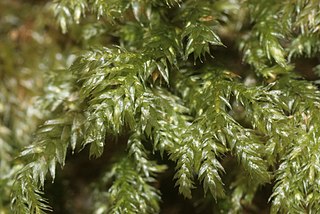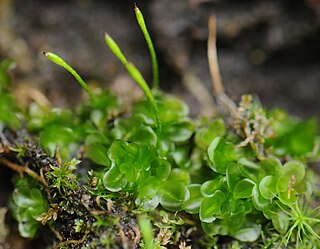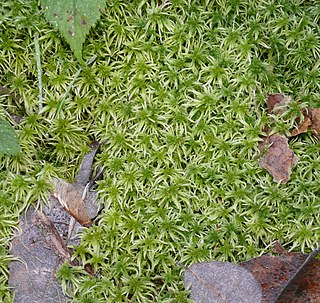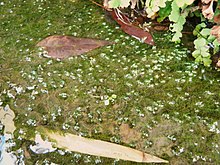Rhytidiadelphus triquetrus, the big shaggy-moss or rough goose neck moss, is a species of moss in the family Hylocomiaceae. It is often the dominating moss species in moderately rich forest habitats in the boreal regions and the Pacific Northwest. Because of its fuzzy appearance and tail-like shape it is also called the 'electrified cat's tail moss'. Not to be confused with square goose-necked moss, Rhytidiadelphus squarrosus.

Schistostega pennata, also called goblin gold, Dragon's gold,luminous moss or luminescent moss, is a haplolepideous moss (Dicranidae) known for its glowing appearance in dark places. It is the only member of the family Schistostegaceae.

Helodium blandowii, also known as Blandow's helodium moss, Blandow's tamarisk-moss, Blandow's bogmoss, and Blandow's feathermoss, is a rare plant in the Western U.S., including Oregon and California. It occurs all around the northern hemisphere in higher latitudes, and in some places is not as rare as in the Western U.S.

Isothecium myosuroides, commonly known as slender mouse-tail moss or tree moss, is a true moss that grows abundantly on both rocks and trees. It is native to Western and Eastern North America, as well as parts of Western Europe. It grows preferentially on angiosperms rather than on conifers because of the manner in which the former take in water creating an ideal moist habitat for the moss to grow on, and because many trees in the flowering plant families are less acidic than coniferous species of trees. Isothecium myosuroides also can grow on rocks.
Thamnobryum angustifolium, the Derbyshire feathermoss, is a species of moss in the Neckeraceae family. It is endemic to Derbyshire, England, being restricted to a single SSSI, where the main colony covers about 3 square metres (32 sq ft) of a single rock face, with small subsidiary colonies nearby. Threats include disturbance from cavers and climbers, collection by bryologists, pollution of the spring in which it grows, and desiccation during periods of drought. Its natural habitat is rivers.

Oedipodium is the only genus of moss in the family Oedipodiaceae. It contains the single species Oedipodium griffithianum, the gouty-moss or Griffith's oedipodium moss. This species is distributed in cooler climates of Eurasia, as well as from Alaska, Washington state, British Columbia, Yukon, Greenland, Newfoundland, Tierra del Fuego and the Falkland Islands.

Ceratodon purpureus is a dioicous moss with a color ranging from yellow-green to red. The height amounts to 3 centimeters. It is found worldwide, mainly in urban areas and next to roads on dry sand soils. It can grow in a very wide variety of habitats, from polluted highway shoulders and mine tailings to areas recently denuded by wildfire to the bright slopes of Antarctica. Its common names include redshank, purple forkmoss, ceratodon moss, fire moss, and purple horn toothed moss.

Plagiomnium medium, commonly known as Alpine thyme-moss or intermediate plagiomnium moss, is a moss found in montane habitats in the Northern Hemisphere.

Sphagnum girgensohnii, also known as Girgensohn's bogmoss, Girgensohn's sphagnum or common green peat moss, is a species of peat moss with a Holarctic and Indo-Malesian distribution.

Marchantia polymorpha is a species of large thalloid liverwort in the class Marchantiopsida. M. polymorpha is highly variable in appearance and contains several subspecies. This species is dioicous, having separate male and female plants. M. polymorpha has a wide distribution and is found worldwide. Common names include common liverwort or umbrella liverwort.

Funaria hygrometrica, the bonfire moss or common cord-moss, is a type of water moss which grows on shady, moist soil. It can also be found on moist walls and the crevices of rocks and places where recent fires have taken place. It has been reported to grow in Niagara Cave, an artificially illuminated cave devoid of natural light. Under such conditions, its growth form changes so that the internodes lengthen and the leaves become longer and narrower.

Platyhypnidium riparioides, the long-beaked water feathermoss, is a species of aquatic moss commonly found in many regions. This species is among the largest aquatic mosses growing up to 15 cm long. P. riparioides grows in a procumbent or pendulous fashion along rocks and tree roots and may form extensive lax mats of many intermingled plants. It is widely distributed South of the Arctic and can grow abundantly in suitable areas.

Sphagnum palustre, the prairie sphagnum or blunt-leaved bogmoss, is a species of peat moss from the genus Sphagnum, in the family Sphagnaceae. Like other mosses of this type it can soak up water up to the 30-fold amount of its own dry weight thanks to its elastic spiral fibers. S. palustre is rather frequent and is spread almost all over the world. It mainly grows in wet forests and—compared to other specimens of this genus—rarely grows in moors.

Polytrichum juniperinum, commonly known as juniper haircap or juniper polytrichum moss, is an evergreen and perennial species of moss that is widely distributed, growing on every continent including Antarctica.

Splachnum sphaericum, also known as pinkstink dung moss, is a species of moss. This species occurs in North America. It also occurs in upland Britain, where it is known as round-fruited collar-moss and in north temperate and boreal regions of Europe. Its habitat is bog and wet heathland where it grows on herbivore dung. This and other Splachnum species are entomophilous. The sporophytes, which are generally coloured red or black, produce an odour of carrion that is attractive to flies and the spores are dispersed by flies to fresh dung.

Calliergon giganteum, the giant spearmoss, giant calliergon moss, or arctic moss, is an aquatic plant found on lake beds in tundra regions. It has no wood stems or flowers, and has small rootlets instead of roots.

Fontinalis antipyretica, greater water-moss, or common water moss, is a species of submerged aquatic moss belonging to the subclass Bryidae. It is found in both still and flowing freshwater in Europe, Asia, Greenland and Africa. In North America it is found in most Canadian provinces with a seaboard and most US states except the most southern.
Ditrichum cornubicum, commonly known as the Cornish path-moss, is a moss endemic to Cornwall, United Kingdom. First discovered in 1963, on a roadside west of Lanner, Cornwall by Jean Paton, it has since been found in two other places within Cornwall. It was published as new to science in 1976.

Ptychostomum capillare, formerly designated as Bryum capillare, is a species of moss belonging to the family Bryaceae. It is known as capillary thread-moss.

Cryptogramma stelleri, common names slender cliff-brake, fragile rock-brake, slender rock-brake, and Steller's rockbrake, is a plant found in North America. It is listed as endangered in Connecticut, Massachusetts, New Jersey, and Pennsylvania. It is listed as threatened in Maine and New Hampshire, as exploitably vulnerable in New York (state) and as sensitive in Washington (state).

















